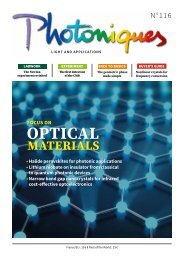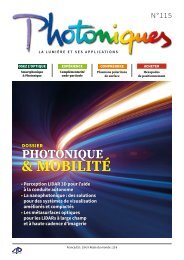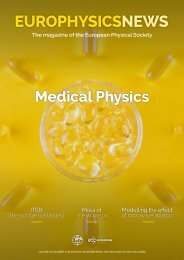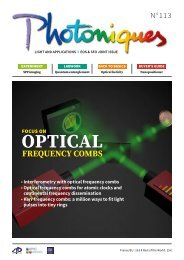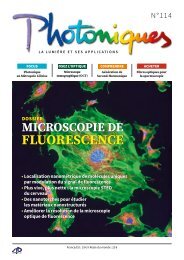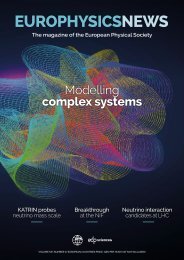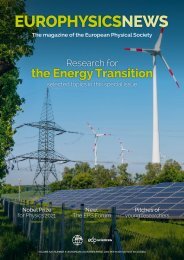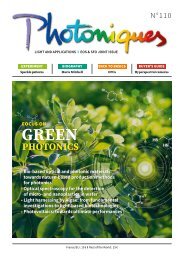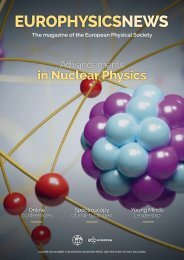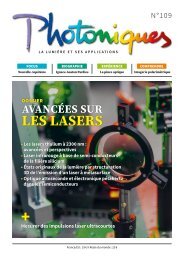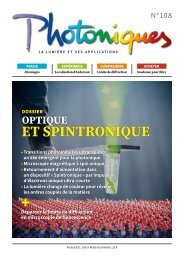Europhysics News 53-4
Europhysics News Quantum Issue
Europhysics News Quantum Issue
You also want an ePaper? Increase the reach of your titles
YUMPU automatically turns print PDFs into web optimized ePapers that Google loves.
FEATURES<br />
Quantum games<br />
. In the tutorial<br />
of Q|Cards><br />
Online qubits are<br />
represented as<br />
merpersons sitting<br />
on a ball. In the ‘Cards<br />
Library’ the players/<br />
learners can find a<br />
description of the<br />
action performed by<br />
each card/gate and<br />
play with the input<br />
state to see how the<br />
output changes.<br />
18 EPN <strong>53</strong>/4<br />
more ‘serious’ games related to business and social impact<br />
challenges, to games exploited as an educational strategy.<br />
Cognitive neuroscience has provided considerable empirical<br />
evidence on how our brains are positively affected<br />
by games from a learning perspective. Games are an effective<br />
way to learn because, increasing attention and focus<br />
levels, keeping our brains engaged and happy, they create<br />
favourable biochemical conditions for synaptic networks<br />
to be created and learning to happen. In fact, not only<br />
game-based learning (GBL) can help especially children to<br />
develop a set of skills that are considered to be essential in<br />
their future jobs: critical thinking, problem solving, resilience,<br />
collaboration, analytical skills, but as they allow gamers-learners<br />
to enjoy challenges and play, which increases<br />
the willingness and excitement to take risks and even accept<br />
failing as part of improvement and learning processes,<br />
whereas risk-taking is otherwise a step people typically<br />
tend to avoid. More in general, GBL allows people of all<br />
ages to approach learning with a hands-on, inquiry-driven,<br />
game-based sets of activities which hard-wire knowledge,<br />
skills and competences in our brains.<br />
Indeed, given the pressing need to make QT accessible to<br />
a wider audience and to facilitate the inclusion of stakeholders<br />
in the debate on the topic, learning quantum concepts<br />
through games has gained prominence as an approach to<br />
support the quantum community at large in its outreach and<br />
education efforts [1]. Quantum phenomena and problems<br />
require imagination, thinking outside the box and exploring<br />
broad solution landscapes. GBL could therefore be a valuable<br />
resource for both real games and learning.<br />
Among the resources offered by QPL, QUEST consists<br />
of a quantum dictionary containing a list of key quantum<br />
concepts. Each entry is explored using a methodology<br />
based on the different approaches to learning described<br />
above, from intuition to formalisation. In particular, all<br />
the various QUEST entries include a 'Play' section in<br />
which proprietary games, developed by the QPL team, are<br />
combined with games developed by other stakeholders<br />
and collaborators as part of the QPL network, carefully<br />
selected from the available games. Some of the games<br />
were born in the context of the Quantum Game Jams we<br />
co-organised, as in the case of the board game Q|Cards><br />
developed during the Quantum Game Jam 2019 by some<br />
of the authors and other collaborators, or the more recent<br />
Potatoes Quest, developed during the IF Quantum<br />
Game Jam 2020 by two students at the University of Pisa.<br />
In QPL, all games are used with the aim of helping<br />
learners develop insight into the ‘strange’ (to the human<br />
eye) behaviours of QP. Therefore, games are used as educational<br />
tools, hence all falling under the umbrella of<br />
the GBL. Currently, concepts explored through the games<br />
published on the QPL platform are: quantum physics,<br />
quantum state, qubit, superposition, entanglement,<br />
quantum measurement, wave-like behaviour, tunneling,<br />
quantum technologies. In the following section, we will<br />
present one of these games.<br />
Q|Cards> Online: a new video game<br />
to learn about quantum computation<br />
Q|Cards> started as a prototype board game developed<br />
during the Helsinki-based Quantum Game Jam 2019<br />
'Quantum Wheel', later refined and co-produced together<br />
with the Finnish company MiTale. In Summer 2021, QPL<br />
launched the mobile game Q|Cards> Online, a fully digital<br />
and online multiplayer version of its tabletop ancestor<br />
Q|Cards> [2].<br />
As in the board game Q|Cards>, each player starts<br />
with a qubit in the |0> state and the goal during the game<br />
is to maximise the probability that, at the end of each turn,<br />
their qubit goes from |0> to |1>. During their turn, players<br />
can apply their cards to any player's qubit line, which<br />
corresponds to applying single- or two-qubit gates and<br />
forming a quantum circuit together with the cards/gates<br />
placed by the other players.<br />
There are multilevel ways to play the game, just for fun<br />
or for delving into the physics behind it. Either way, to<br />
win or at least play consciously, players need to understand<br />
even roughly what a qubit is, how to manipulate<br />
it through gates and also why probabilities are involved.<br />
Therefore, Q|Cards> can be exploited as an educational<br />
resource to teach the basic notions of quantum information<br />
and computing, but also QP concepts such as superposition,<br />
entanglement, and quantum measurement.<br />
In addition, the game runs on a real quantum device.<br />
The 2- to 5-qubit quantum circuit resulting from<br />
the game is automatically translated into IBM Qiskit and<br />
the corresponding circuit is simulated or executed on a<br />
real IBM Q cloud quantum computer.<br />
Q|Cards> Online is accompanied by a tutorial explaining<br />
rules and actions of the various cards/gates, where<br />
qubits are pictorially represented as merpersons sitting<br />
on a ball. The imaginative pictures allow for a level of explanation<br />
that can be adapted to the audience. Hence, it<br />
is sufficient for pupils and young learners to think about<br />
the upright and upside down configuration of the seated<br />
merperson representing the qubits’ basis states |1> and<br />
|0>; for high-school students it is easy to explain the Bloch



